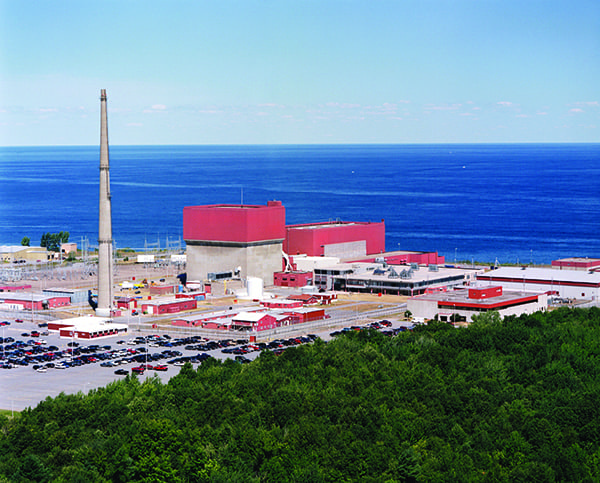U.S. Nuclear: From Hope to Despair
A decade ago, the annual Platts nuclear energy conference in Washington was brimming with optimism over a coming “nuclear renaissance,” as licensing requests poured into the Nuclear Regulatory Commission and companies announced ambitious plans for new nuclear construction. Ten years later, the not-so-under-the-surface theme of the conference was nuclear survival.
“The question is survival,” former Entergy nuclear executive Bill Mohl told attendees at the annual Platts nuclear energy conference in Washington, D.C., in early February. Mohl, who led Entergy’s merchant power business and retired February 28, went on to explain that Entergy’s long-term strategy of buying up single-unit nuclear plants at bargain-basement prices and bidding them into the regional transmission operator (RTO) and independent system operator (ISO) competitive wholesale markets was a miserable failure.
It seemed like a really good idea at the outset, but a combination of factors undercut the strategy, and Entergy is now exiting merchant nuclear power in as big a way as it entered. Vermont Yankee is shuttered. It has agreed to sell FitzPatrick (Figure 1) in New York to Exelon. Palisades in Michigan will close in the fall of 2018. Pilgrim on Cape Cod will close in the fall of 2019. The two Indian Point units on the Hudson River 35 miles north of New York City will shut down in 2020 and 2021. It’s a sad state of affairs for the company and the industry.
Nuclear on the Brink
The U.S. has seen nine GW of nuclear plant closures announced over the past few years, nearly 10% of national nuclear generating capacity. Mohl (Figure 2) noted that “it would have been worse” if Exelon, the nation’s largest nuclear generator, had not been able to save two Illinois facilities (Quad Cities and Clinton) and four upstate New York units (FitzPatrick, Ginna, and two Nine Mile Point reactors). All were rescued by state-orchestrated bailouts designed to assign a value to the avoided carbon dioxide emissions from the plants.
Independent generators are challenging the Illinois and New York subsidies for the nuclear units in court and at the Federal Energy Regulatory Commission. They argue that the state plans distort the competitive wholesale auctions. Those challenges could upset the Illinois and New York plans to save the nuclear units in competitive markets.
In January, the independent market monitor for the PJM Interconnection, the largest of the competitive markets, said in a federal court filing that the New York program is unlawful as it discriminates against other fuels—natural gas and coal. The nuclear subsidies, said the filing, “will result in keeping noneconomic plants in the NYISO market despite market signals to retire.”
What accounts for the inability of nuclear to compete in wholesale markets? Several speakers at the Platts conference agreed on the fundamental problems. They include:
■ Low wholesale prices. Hydraulic fracturing technology arrived about a decade ago, producing astonishing new supplies of natural gas, which provided cheap fuel for power plants and drove market prices down. Long-running federal tax subsidies for renewables, particularly wind, have also hampered the ability of nuclear to compete.
■ Low demand growth. Wholesale market prices have reflected the fact that the “great recession” and increasing end-use energy efficiency have slowed growth in demand for electricity, pushing prices lower. The reduced demand growth seems baked into the U.S. market.
■ Flawed market design. The nuclear industry argues that the technology’s carbon-free nature does not get any value in competitive markets.
■ Increased operating costs. Post-9/11 security measures and Nuclear Regulatory Commission orders in the wake of the 2011 Fukushima disaster have driven costs higher. Exelon’s Chris Mudrick said his company now employs more security personnel at its nuclear sites than plant operators. He said Exelon has a goal of reducing the cost of its nuclear generation by 30%, but he and Mohl agreed that cost reductions won’t solve nuclear’s problems in competitive markets. “You can’t save yourself to prosperity,” said Mohl.
The current nuclear carnage looks likely to continue. A January report from the National Conference of State Legislatures noted, “Since 2013, six nuclear reactors in the United States have permanently closed, another 12 reactors have been scheduled to shut down, and operators at several more plants have warned of other possible reactor closures in the coming years.”
Environmental Progress, a pro-nuclear group, recently released an analysis concluding that a quarter to two-thirds of operating U.S. nuclear plants could face premature closure. The Environmental Progress analysis counts 35 GW of nuclear capacity as at “triple risk” because “they are in deregulated markets, uneconomical (according to Bloomberg New Energy Finance) and up for relicensing before the end of 2030.” Which plants are in greatest jeopardy of early closure? The answer, according to the group, is D.C. Cook in Michigan; Seabrook in New Hampshire; Millstone in Connecticut; and Davis-Besse in Ohio.
Regulated Markets Are the Lifeblood
The only bright spot for nuclear is in southern states where traditional, state-regulated cost-of-service regimes continue to govern how nuclear plants make money. In contrast to its merchant nuclear fleet, Entergy’s two Arkansas Nuclear One units, the Grand Gulf plant in Mississippi, and River Bend and Waterford 3 in Louisiana are doing well.
The only new U.S. plants under construction are two units in Georgia and two in South Carolina. Both states have regulations that allow the utilities building the plants to recover their costs of construction (and earn a profit) while the plants are being built. State-regulated wholesale and retail markets serve about 40% of the U.S. population.
Even in these regulatory-friendly environs, little real enthusiasm for new nuclear plants exists. That’s driven by the cost overruns and delays that the nuclear projects in Georgia and South Carolina have experienced.
“No utility in its right mind is going to build a new plant,” a southern utility executive told POWER on condition of anonymity at the Platts meeting. “It’s a bet-the-company proposition and the odds aren’t positive enough, even with construction-work-in-progress policies. Some may talk the talk. Nobody is going to walk the walk.”
Nuclear Lobby Shakeup
The current industry woes are reflected in its Washington lobbying group, the Nuclear Energy Institute (NEI). The same day as the Platts conference began in Washington, new NEI CEO Maria Korsnick (Figure 3) was briefing Wall Street analysts in New York. Although Korsnick, an Exelon veteran who replaced retired CEO Marvin Fertel January 1, put on a brave face, she had to acknowledge that existing plants are in jeopardy.
 |
3. Promoting nuclear power. Maria Korsnick became CEO of the Nuclear Energy Institute, following the retirement of Marvin Fertel. Courtesy: Nuclear Energy Institute |
“The grid of the future will include a growing role for intermittent renewable energy,” she said. “So the nuclear reactors of the future will accommodate that reality. Some will make electricity around the clock. Others will produce electricity when it’s needed, then produce other products when it is not. Some will supply the transportation market. Nuclear electricity will charge batteries and nuclear process heat will make alternative fuels. Some reactors will make fresh water. Some will drive industrial production. Some reactors might even produce energy from today’s used fuel, reducing the disposal burden.”
But the immediate objective, Korsnick said, is preserving the existing nuclear plants. “We are reaching a tipping point as policymakers have come to appreciate the risk of losing nuclear plants. However, I believe the tide is turning. The federal government, the regional transmission organizations and the states now recognize the problem, and are moving to reform the competitive markets where the greatest threats exist.” Little evidence exists to support that optimism.
NEI itself has gotten a haircut of sorts. Nucleonics Week, a Platts publication, reported in late January that NEI has cut its staff by 13%, or 16 jobs, including the departure of high-ranking staffers. The newsletter quoted an unidentified nuclear industry official who reportedly said, NEI “hasn’t just downsized and cut costs, but replaced all of the leadership positions, which adds up to member dissatisfaction with the way NEI was operating. If it’s a primary job to defend the current fleet and they continue to close, then [NEI] is not doing its job.”
Among the NEI departures were Alex Flint, the group’s veteran top lobbyist; Scott Peterson, senior vice president for communications; and Steve Kerekes, long-time head of media relations. The lobbying group brought in some new blood. Neal Cohen from APCO Worldwide was made top lobbyist and strategist, and John Kotek—former Department of Energy (DOE) acting assistant secretary for nuclear energy—will now run communications and policy development.
While NEI’s traditional focus has been on federal affairs, that’s not a promising agenda today. Wholesale market structure belongs to the Federal Energy Regulatory Commission (FERC), which is unable to take up big issues with only two of five commission seats filled (both with Democrats). Getting FERC operational on big-picture items will take some time, and there is no certainty the commission will be willing to meet the nuclear industry’s vision for the future. To meet the desires of nuclear generators, FERC would have to overturn the restructured wholesale markets it created 20 years ago, and they appear to be functioning as designed.
As this story goes into production in early March, the DOE does not have a complete leadership team in place. Former Texas Gov. Rick Perry was confirmed as energy secretary on March 2, despite his previous position in favor of abolishing the agency, but he still has to fill many leadership positions, which can take time. But the DOE doesn’t really have much to do with promoting nuclear power, other than supporting research and development.
The Nuclear Regulatory Commission (NRC) can make life easier for the nukes, but only at the margins. The industry’s problems are more economic than regulatory. The NRC has few tools to deal with the economic impediments to nuclear in wholesale markets.
Subsidies Offer a Lifeline
The industry has had some success at the state level however. Both the Illinois and New York bailouts were major wins for Exelon. NEI also led a 2016 repeal of a 33-year-old Wisconsin law banning new nuclear power plants in the state, as Christine Csizmadia described at the Platts conference. Even so, there is no evidence of any serious interest in actually building a new nuclear plant in Wisconsin.
NEI’s Korsnick told Wall Street analysts, “New York and Illinois serve as examples to other states that effective solutions are possible, even in competitive markets. The nuclear industry is sharpening the focus of its advocacy efforts in other states where major policy opportunities exist.”
Exelon’s David Fein told the Platts meeting about the Illinois and New York plant rescues. In Illinois, the more difficult case, a Republican governor and a Democratic legislature were at war. Three years in, the state still does not have an approved budget. Exelon had to work with supporters, including unions representing plant workers, on an overall rescue package that included something for almost every stakeholder, to move a bill through the legislature and win the governor’s signature.
New York was easier, Fein said. Powerful Gov. Andrew Cuomo was able to take a regulatory path to the nuclear rescue. His control of the state public service commission eased the way to a compromise satisfactory to most of the interests in the state, although not to the nonutility generators. It didn’t require state legislation.
Fein noted that efforts are underway in Connecticut and Pennsylvania to rescue threatened nuclear plants. In Connecticut, the task is to protect the two awkwardly-named Millstone units in the ISO New England competitive market. That will take legislative action. The UtilityDive website reported in mid-February, “The legislation, yet to be fully drafted, now only indicates it would ‘provide a mechanism for zero-carbon generating facilities to sell power to electric utilities.’ The Millstone plant, like other nuclear facilities in organized markets, is challenged by competition from cheap natural gas generation.”
In Pennsylvania, where Ohio-based FirstEnergy is trying to exit the merchant market entirely, its two-unit Beaver Valley station in historic Shippingport, Pa., is at risk, as is its Ohio Perry plant. All are bidders into the PJM Interconnection. Exelon’s Fein said developments in Pennsylvania are currently on hold.
Is a Carbon Tax the Remedy?
But state bailout programs, Exelon’s Mudrick and Entergy’s Mohl agreed, aren’t the long-term answer. “Somebody has to make it a priority at the federal level,” said Mohl, advocating a nationwide carbon tax, suggesting a $17/ton initial price, readjusted every two years. If the feds—meaning Congress and the Trump administration—can’t come up with a national solution, said Mohl, “it will be relegated to the states and that cannibalizes” the competitive markets, an entirely undesirable outcome.
 |
4. Low-carbon Illinois. Hundreds of nuclear power proponents rallied at the Illinois state Capitol in support of the state’s low-carbon portfolio standard. Courtesy: Exelon Generation |
The day before the Platts nuclear conference, a group of establishment Republicans—including James Baker and George Shultz, former secretaries of state; Henry Paulson, former treasury secretary; and Martin Feldstein and Gregory Mankiw, former White House economic advisors—rolled out a paper advocating a nationwide tax on carbon dioxide emissions. They dubbed it, “The Conservative Case for Carbon Dividends.” They unveiled it in a New York Times op-ed column. The tax would be coupled with a rollback of the Obama administration’s Environmental Protection Agency (EPA) regulations on power plant CO2 emissions.
The tax would start at a suggested $40/ton and escalate over time. The paper argues, “Mounting evidence of climate change is growing too strong to ignore. While the extent to which climate change is due to man-made causes can be questioned, the risks associated with future warming are too big and should be hedged. At least we need an insurance policy.”
The GOP graybeards’ plan would require major congressional legislation, perhaps including a rewrite of the Clean Air Act’s 1990 amendments. That’s a real stretch.
Trump is deeply skeptical of global warming science. Republicans have a traditional aversion to anything labeled a tax. Mainstream environmental groups are likely to raise opposition to a rollback of EPA regulations. David Doniger, long-time head of climate programs for the Natural Resources Defense Council, promptly responded to the establishment GOP proposal, praising the effort but saying, “The atmosphere needs a guarantee, and that’s why we need firm carbon pollution limits in addition to carbon prices.”■
—Kennedy Maize is a long-time energy journalist and frequent contributor to POWER.

